Florithrips traegardhi (Trybom, 1911)
Thripinae, Thripidae, Terebrantia, Thysanoptera
Figures
Fig. 1: 8-segmented antenna, segments III and IV with forked sense cone, terminal segments V-VIII
Fig. 2: Head dorsal with ocellar triangle
Fig. 3: Pronotum
Fig. 4: Meso- and metanotum
Fig. 5: Fore wing basal region, clavus
Fig. 6: Fore wing and distal region of fore wing
Fig. 7: Sternite VII
Fig. 8: Tergite VIII with posteromarginal comb
Introduction and recognition
Florithrips traegardhi can cause leaf damage on several grasses, cereal crops and sugar cane. Both sexes macropterous; body light yellow; tip of tarsi dark; antennal segments I & II light yellowish, III-VI basally yellow and distally grey, VII & VIII grey; fore wings very pale yellowish. Antennae 8-segmented; segments III & IV with forked sense cone, microtrichia on III-VI (Fig. 1). Head wider than long; 4 pairs of ocellar setae or more, interocellar pair long and arising on or behind tangent of anterior margin of hind ocelli (Fig. 2). Pronotum with distinct transverse lines of sculpture; with 2 pairs of long posteroangular setae (Fig. 3). Mesosternal furca with median spinula. Metanotum medially with mainly equiangular reticulation; median setae longer than lateral setae and arising at anterior margin; campaniform sensilla present (Fig. 4). Mid and hind tarsi 2-segmented. Fore wings first vein with 2 distal setae; second vein with a complete row of 13-16 setae (Fig. 5 and 6). Tergites laterally and pleurotergites with dense rows of microtrichia along lines of sculpture; tergite VIII with complete posteromarginal comb of long and slender microtrichia (Fig. 8); tergite X without longitudinal split. Sternites without discal setae; median setae of sternite VII arising in front of posterior margin (Fig. 7).
Male similar to female; sternites III-VII each with a transverse glandular area medially.
Taxonomic identity
Species
Florithrips traegardhi (Trybom, 1911)
Taxonomic history
Taeniothrips fulvus Ananthakrishnan & Jagadish, 1969
Taeniothrips traegardhi Priesner, 1938
Taeniothrips niloticus Priesner, 1930
Anaphothrips ramakrishnai Karny, 1927
Physothrips traegardhi Karny, 1914
Physapus traegardhi Trybom, 1911
Common name
-
Present taxonomic position
Family: Thripidae Stephens, 1829
Subfamily: Thripinae (Stephens) Karny, 1921
Genus: Florithrips Bhatti, 1970
Genus description
The genus Florithrips Bhatti, 1970
2 species from Africa, Florithrips dilutus and Florithrips traegardhi are placed in this genus. Florithrips traegardhi, is widespread throughout the Sahel zone from Morocco and Senegal to Bangladesh (Mound & Kibby 1998). The genus is characterised by having 4 pairs of ocellar setae or more, second vein of fore wings with 6 or more setae, tergite X without split, and pleurotergites with dense rows of microtrichia (Bhatti 1969).
Species description
Typical key character states of Florithrips traegardhi
Coloration and body sculpture
Body color: mainly pale to yellow, or with some darker markings
Surface of head, pronotum and fore legs: without obvious or with weakly reticulate sculpture
Antennae
Form of sense cones on antennal segments III and IV: emergent and forked on segments III and IV
Number of antennal segments: 8
Antennal segment I: without any setae on dorsal apical margin
Antennal segment II: without an exceptionally long seta at the inner apex
Antennal segment II shape: symmetric
Antennal segment III shape: symmetric
Length of antennal segment III and IV: antennal segment III similar in length to segment IV
Forked sense cone on antennal segment IV: scarcely extending beyond base of segment V
Antennal segment IV and V: without a hyaline ring near the base
Antennal segment VI bears: not a remarkably dagger-shaped sensorium
Head
Distance between bases of ocellar setae III: greater than width of first ocellus
Head: not prolonged in front of compound eyes
Ocellar setae I: present
Ocellar setae III: arising on anterior margin of, or between hind ocelli
Ocelli: present
Head length to wide: length < width
Length of postocular setae: not alternating short and long setae
Ocellar setae I position: short and behind base of scape and in front of anterior ocellus
Number of ocellar setae: 4-6
Prothorax
Number of pairs of long anteroangular setae: 0
Number of pairs of long posteroangular setae: 2
Number of pairs of elongate pronotal setae: 2
Pronotal blotch or internal apodeme: absent
Pronotum shape: broadly rectangular
Pronotum posteromarginal/posteroangular setae: S2 longer than S3, not equal in length
Mesothorax
Mesosternal furca: with median spinula
Metathorax
Metanotal campaniform sensilla: present
Metanotal median setae: S1 at anterior margin
Metanotum with dominant sculptured triangle medially: absent
Metasternal furca: without spinula
Sculpture of metanotum median area: with mainly equiangular reticulation
Shape of metathoracic furca: transverse, V-shaped
Metanotal median setae length: longer than lateral metanotal setae
Wings
Fore and hind wings: present, more than half as long as abdomen (macropterous)
Fringe cilia arising: from sockets
Fore wing veins: present
Fore- and hind wing surface: covered with microtrichia
Apex of fore wing: with prominent terminal setae
Fore wing anterior margin (costal vein): with setae and cilia but cilia longer than setae
Fore wing costal fringe cilia: arising at anterior margin of wing
Fore wing first vein: distinct from costal vein
Fore wing first vein setal row: incomplete, with setae not closely and uniformly spaced
Fore wing number of setae of second vein: 13-16
Fore wing second vein setal row: complete, setae uniformly spaced
Fore wing shape: mainly parallel sided or margins run continuously towards each other
Fore wing surface: not reticulate
Fore wing first vein number of setae on distal half: 2
Fringe cilia on posterior margin near apex: distinctly wavy (undulated)
Length of fore wing costal setae at middle of wing: longer than half of median wing width
Shape of fore wing apex: with mainly posterior margin curved to join anterior margin
Fore wing extreme apex color: pale
Fore wings: uniformly pale or weakly shaded
Legs
Fore tibia: not prolonged around fore tarsus
Mid and hind tarsi: with two segments
Color of fore tarsi: pale or yellow, sometimes apical shaded or brown
Abdomen
Pleurotergites: with many rows of fine microtrichia
Sternite II: with marginal setae but no discal setae
Sternites IV, V and VI: with marginal setae but no discal setae
Sternite VII median posteromarginal setae S1: arising in front of posterior margin
Sternite VII: with marginal setae but no discal setae
Number of lateral marginal setae on tergite II: 3
Tergites II to VII median setal pair: no more than 0.3 as long as median length of tergite
Tergites IV and V median setal pair: shorter than distance between their bases
Tergites V to VII: without ctenidia laterally, but sometimes with rows of microtrichia
Craspedum on tergites IV to VI: absent
Craspedum on tergite VIII: without craspedum medially and toothlike microtrichia laterally
Tergite VIII ctenidia: without paired ctenidia laterally, sometimes with irregular microtrichia
Tergite VIII posteromarginal comb of microtrichia: present and complete medially
Tergite VIII shape of posteromarginal microtrichia: long, slender and irregular or regular
Tergite X: not tubular, longitudinally incomplete
Setae on abdominal tergite X: all setae slender

Similar or related species
Florithrips traegardhi differs from all other species of Thripinae in having 4 pairs of ocellar setae or more (species of other genera with 2 or 3 pairs of ocellar setae). Furthermore, it is one of few species that bears dense rows of microtrichia on pleurotergites and laterally on tergites. Similarly, species of the genus Scirtothrips have pleurotergites and tergites laterally covered with fine microtrichia, but in Scirtothrips these are arranged in closely spaced rows, whereas in Florithrips traegardhi these microtrichia extend along lines of sculpture. In addition, tergites II-VII of Scirtothrips species have a fine comb laterally at posterior margin, and sternites covered with rows of microtrichia, which lacking in Florithrips traegardhi. A few species of the genus Thrips have also pleurotergites covered with many rows of fine microtrichia (Thrips acaciae, Thrips gowdeyi, Thrips simplex, Thrips subnudula, Thrips tabaci), but no microtrichia laterally on the tergites.
Biology
Life history
As with other thrips species the life cycle from egg to adult is dependent on temperature. The full cycle can take less than one week to over a month and adults may live for more than one month producing several generations in one year depending on seasonal weather (Lewis 1973).
Host plants
Crops: amaranthus, beans, capsicum, cashew, groundnut, granate apple, kale, maize, onion, rice, sorghum, sugarcane, tomato, wheat.
Weeds: Acanthospermum hispidum, Bidens pilosa, Senna longiracemosa, Senna occidentalis, Sphaeranthus ukambensis var. ukambensis, Tagetus minuta.
Vector capacity
None identified, but possible mechanical distribution of phytopathogenic fungi and bacteria.
Damage and symptoms
The species is common on ears, leaves and leaf-sheaths of many grasses, cereal crops and sugarcane. In large numbers it can cause severe bleaching of the leaves.
Detection and control strategies
-
Additional notes
-
Biogeography
India, southern Mediterranean, Yemen, Africa.
Egypt (Pyramids Road near Cairo; Kerdasa; Gezirah - northern Nile Island in Cairo),
Kenya, Morocco,
Senegal (Fété Olé),
Sudan (Kaka).
African countries where Florithrips traegardhi has been reported

Occurence of Florithrips traegardhi in East Africa

Please click here for survey sites of all observed thrips species of Kenya, Tanzania and Uganda.
Click here for locations of Florithrips traegardhi in parts of East Africa.

Bibliography
Ananthakrishnan TN (1971). Thrips (Thysanoptera) in agriculture, horticulture & forestry - diagnosis, bionomics & control. Journal of Scientific and Industrial Research. 30 (3): 113-146
Ananthakrishnan TN & Jagadish A (1969). On some species of Taeniothrips Serville and Thrips Linn. with further notes on Hyalopterothrips roonwali Bhatti from India. Zoologischer Anzeiger. 182: 113-121
Bhatti JS (1969). Taxonomic studies in some Thripini (Thysanoptera: Thripidae). Oriental Insects. 3 (4): 373-382
Karny H (1926). Studies on Indian Thysanoptera. Memoirs of the Department of Agriculture in India, Entomological Series. 9 (6): 187-239
Karny H, van Leeuwen-Reijnvaan W & van Leeuwen-Reijnvaan J (1914). Beiträge zur Kenntnis der Gallen von Java. Zweite Mitteilung über die javanischen Thysanopterocecidien und deren Bewohner. Zeitschrift für Wissenschaftliche Insektenbiologie. 10: 355-369
Lewis T (1973). Thrips: their biology, ecology and economic importance. Academic Press Inc., London Ltd., 349 pp
Lewis T (1997). Thrips as crop pests. CAB International, Wallingford, 740 pp
Mound LA & Kibby G (1998). Thysanoptera: An identification guide, (2nd edition). CAB International, Wallingford and New York, 70 pp
Palmer JM (1990). Identification of the common thrips of Tropical Africa (Thysanoptera, Insecta). Tropical Pest Management. 36 (1): 27-49
Pitkin BR & Mound LA (1973). A catalogue of West African Thysanoptera. Bulletin de ľInstitut Fondamental ďAfrique Noire, Série A. 35 (2): 407-449
Priesner H (1930). Contribution towards a knowledge of the Thysanoptera of Egypt, III. Bulletin de la Société Royale Entomologique ďEgypte. 14: 6-15
Priesner H (1938). Contributions towards a knowledge of the Thysanoptera of Egypt, XI . Bulletin de la Société Royale Entomologique ďEgypte. 21: 208-222
Trybom F (1911). Physapoden aus Ãgypten und dem Sudan. Results of the Swedish Zoological Expedition to Egypt and the White Nile (1900-1901) under the direction of L. A. Jagerskiold. 19: 1-16
zur Strassen R (2003). Die terebranten Thysanopteren Europas und des Mittelmeer-Gebietes. Die Tierwelt Deutschlands und der angrenzenden Meeresteile nach ihren Merkmalen und nach ihrer Lebensweise, 74. Teil. Goecke & Evers, Keltern, Germany, 277 pp
----
Web links
Mound´s Thysanoptera pages
Thysanoptera Checklist
ICIPE Thrips survey sites
UNI Halle & Thrips sites
Thrips of California












